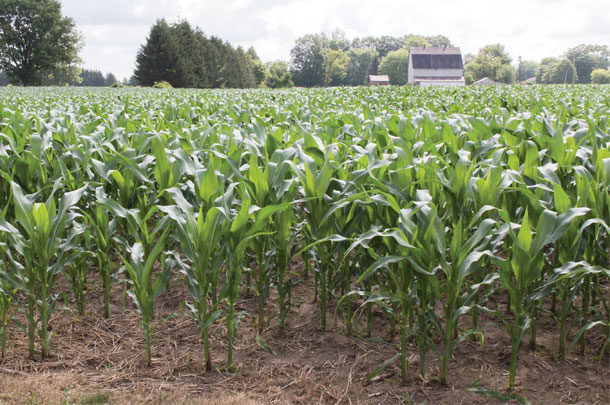First, fewer land-grant universities are planting corn silage hybrid evaluation trials; second, some seed companies have stopped entering hybrids in these university trials; and third, both practical and financial considerations limit the number of hybrids a seed company is willing (or can afford) to enter in the trials, most of which charge entry fees.
The amount of trial data on brown midrib (BMR) hybrids is especially limited; sometimes, one or two BMR hybrids are in a trial, but often none at all. Furthermore, there’s no standability data published on either conventional or BMR hybrids in any of the state university trial reports.
Do BMR hybrids have standability problems? Are there meaningful differences in standability among the various BMR hybrids, including those using the BM-1 versus the BM-3 gene? We don’t lack for opinions on these questions, but it would be nice to have actual data.
Compared to corn grain trials, evaluation of corn hybrids for silage production is labor-intensive and expensive, both during harvest and when the hybrids are analyzed for forage quality. The published information from corn grain trials is often limited to yield and relative maturity (RM), but sometimes it includes standability and test weight. In evaluating corn hybrids for silage, most state university trials test entries for at least a dozen factors, primarily to better characterize forage quality.
Therefore, while the analytical cost of evaluating a grain hybrid is minimal, quality testing of corn hybrids grown for silage production can be quite expensive.
Despite the labor requirements and analytical costs, you can still evaluate corn hybrids for silage on your farm, but you’ll need to limit the number of hybrids tested. Most university trials involve several replications (repetitions) of each hybrid, typically four. Each replication should be randomly assigned, perhaps by drawing hybrid names from a hat for each replication. This allows for a proper statistical analysis. You should plant at least three replications of each hybrid, but more than four reps are probably too many to be practical.
The number of reps may depend on how many hybrids you include in your trial. Some university agronomists suggest up to 10 corn hybrids, but I think 10 is optimistic. At least the first time you attempt an on-farm hybrid trial, I’d suggest limiting it to a maximum of six hybrids. Make sure the field selected for the trial is large enough to accommodate the number of hybrids and replications.
Field variability is the enemy of crop researchers, which is why test fields should be carefully selected for minimal variation in soil type, fertility, pH, etc. Field variability alone can account for a yield difference of between 1 and 5 tons of corn silage per acre, which is the reason for several replications. You’ll want plots large enough to permit harvest with your normal corn silage harvest equipment. The planted area should be wider than the area you harvest for measured yields: Plan on leaving at least two “guard rows” on each side of every replication. Plot size can vary widely, but for corn silage, it’s usually between 0.1 and 0.5 acres for each replication of each hybrid in the trial.
One advantage on-farm trials have over university trials is size: There may be some row shading effect if four rows of a very tall hybrid are planted right next to four rows of a very short hybrid, and then all rows are harvested for yield and quality determination. Large plots will minimize this problem. There’s not much data on the effect of shading on performance, but better safe than sorry.
Trials versus demonstrations
What about nonreplicated trials – planting a single strip of half a dozen or more hybrids in a field that has relatively little variability? Many seed company demonstrations are planted in this manner. You can glean some useful information from this type of trial, including maturity differences between hybrids, disease resistance, standability differences, ear placement and other physical characteristics.
Just knowing if a hybrid has the proper maturity for your farm is useful information. Relative maturity ratings are assigned by the seed company, so there’s no assurance that what one seed company rates as a 105 RM hybrid will have the same maturity as a different seed company’s 105 RM hybrid. I remember good-naturedly chiding a seed company plant breeder, noting that his company tended to be somewhat “optimistic” in assigning relative maturity ratings to some of the corn hybrids it entered in university silage trials. He agreed!
Harvest and sampling procedures
A sample for forage analysis should be submitted from each replication of every hybrid in the trial, doing your best to ensure each sample is as representative as possible. Push a pencil on this before you head for the field with the planter. For instance, six hybrids multiplied by four reps equals 24 forage samples for analysis. Multiply this by the cost per sample, and you’ll see that forage analysis could cost several hundred dollars.
To get a representative sample, take multiple handfuls of chopped silage from each replication, mix thoroughly and remove the required amount to submit for analysis. Don’t hesitate to get your farm’s nutritional consultant(s) involved since they’re likely to know proper sampling procedures. Corn chopped for silage is especially hard to sample accurately because of the big quality differences between grain and stover.
Widely differing analytical results among the several replications of a single hybrid may be due to poor sampling, not differences in field performance. Submit all samples at the same time (preferably in the same shipping container) to a reputable forage laboratory. Most forage labs have several analytical packages, so pick the one that provides the information you want. ![]()
PHOTO: With the lack of public sector trials, producers can conduct on-farm corn hybrid varieties for silage with these recommendations. Photo by Mike Dixon.

-
Everett D. Thomas
- Oak Point Agronomics Ltd.
- Email Everett D. Thomas











